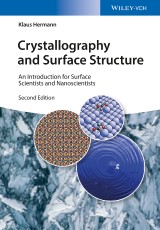Details

Crystallography and Surface Structure
An Introduction for Surface Scientists and Nanoscientists2. Aufl.
|
120,99 € |
|
| Verlag: | Wiley-VCH |
| Format: | EPUB |
| Veröffentl.: | 05.10.2016 |
| ISBN/EAN: | 9783527697144 |
| Sprache: | englisch |
| Anzahl Seiten: | 448 |
DRM-geschütztes eBook, Sie benötigen z.B. Adobe Digital Editions und eine Adobe ID zum Lesen.
Beschreibungen
A valuable learning tool as well as a reference, this book provides students and researchers in surface science and nanoscience with the theoretical crystallographic foundations, which are necessary to understand local structure and symmetry of bulk crystals, including ideal and real single crystal surfaces. The author deals with the subject at an introductory level, providing numerous graphic examples to illustrate the mathematical formalism. The book brings together and logically connects many seemingly disparate structural issues and notations used frequently by surface scientists and nanoscientists. Numerous exercises of varying difficulty, ranging from simple questions to small research projects, are included to stimulate discussions about the different subjects.<br> <br> From the contents:<br> Bulk Crystals, Three-Dimensional Lattices<br> - Crystal Layers, Two-Dimensional Lattices, Symmetry<br> - Ideal Single Crystal Surfaces<br> - Real Crystal Surfaces<br> - Adsorbate layers<br> - Interference Lattices<br> - Chiral Surfaces<br> - Experimental Analysis of Real Crystal Surfaces<br> - Nanoparticles and Crystallites<br> - Quasicrystals<br> - Nanotubes<br>
<p>Preface to the Second Edition IX</p> <p>Preface to the First Edition XI</p> <p><b>1 Introduction 1</b></p> <p><b>2 Bulk Crystals: Three-Dimensional Lattices 7</b></p> <p>2.1 Basic Definition 7</p> <p>2.2 Representation of Bulk Crystals 11</p> <p>2.2.1 Alternative Descriptions Conserving the Lattice Representation 12</p> <p>2.2.2 Alternative Descriptions Affecting the Lattice Representation 14</p> <p>2.2.2.1 Cubic, Hexagonal, and Trigonal Lattices 16</p> <p>2.2.2.2 Superlattices and Repeated Slabs 25</p> <p>2.2.2.3 Linear Transformations of Lattice Vectors 29</p> <p>2.2.3 Centered Lattices 31</p> <p>2.3 Periodicity Cells of Lattices 35</p> <p>2.4 Lattice Symmetry 38</p> <p>2.5 Reciprocal Lattice 49</p> <p>2.6 Neighbor Shells 52</p> <p>2.7 Nanoparticles and Crystallites 63</p> <p>2.8 Incommensurate Crystals and Quasicrystals 71</p> <p>2.8.1 Modulated Structures 71</p> <p>2.8.2 Incommensurate Composite Crystals 73</p> <p>2.8.3 Quasicrystals 76</p> <p>2.9 Exercises 82</p> <p><b>3 Crystal Layers: Two-Dimensional Lattices 91</b></p> <p>3.1 Basic Definition, Miller Indices 91</p> <p>3.2 Netplane-Adapted Lattice Vectors 96</p> <p>3.3 Symmetrically Appropriate Lattice Vectors: Minkowski</p> <p>Reduction 98</p> <p>3.4 Miller Indices for Cubic and Trigonal Lattices 100</p> <p>3.5 Alternative Definition of Miller Indices and Miller–Bravais</p> <p>Indices 106</p> <p>3.6 Symmetry Properties of Netplanes 109</p> <p>3.6.1 Centered Netplanes 110</p> <p>3.6.2 Inversion 111</p> <p>3.6.3 Rotation 114</p> <p>3.6.4 Mirror Operation 119</p> <p>3.6.5 Glide Reflection 131</p> <p>3.6.6 Symmetry Groups 139</p> <p>3.7 Crystal Systems and Bravais Lattices in Two Dimensions 144</p> <p>3.8 Crystallographic Classification of Netplanes and Monolayers 149</p> <p>3.8.1 Oblique Netplanes 151</p> <p>3.8.2 Primitive Rectangular Netplanes 151</p> <p>3.8.3 Centered Rectangular Netplanes 155</p> <p>3.8.4 Square Netplanes 157</p> <p>3.8.5 Hexagonal Netplanes 158</p> <p>3.8.6 Classification Overview 163</p> <p>3.9 Exercises 164</p> <p><b>4 Ideal Single Crystal Surfaces 169</b></p> <p>4.1 Basic Definition, Termination 169</p> <p>4.2 Morphology of Surfaces, Stepped and Kinked Surfaces 175</p> <p>4.3 Miller Index Decomposition 178</p> <p>4.4 Chiral and Achiral Surfaces 192</p> <p>4.5 Exercises 204</p> <p><b>5 Real Crystal Surfaces 209</b></p> <p>5.1 Surface Relaxation 209</p> <p>5.2 Surface Reconstruction 210</p> <p>5.3 Growth Processes 222</p> <p>5.4 Faceting 226</p> <p>5.5 Exercises 231</p> <p><b>6 Adsorbate Layers 235</b></p> <p>6.1 Definition and Classification 235</p> <p>6.2 Adsorbate Sites 241</p> <p>6.3 Wood Notation of Surface Structure 251</p> <p>6.4 High-Order Commensurate (HOC) Overlayers 258</p> <p>6.5 Interference Lattices 263</p> <p>6.5.1 Basic Formalism 264</p> <p>6.5.2 Interference and Wood Notation 272</p> <p>6.5.3 Anisotropic Scaling, Stretching, and Shifting 279</p> <p>6.6 Symmetry and Domain Formation 283</p> <p>6.7 Adsorption at Surfaces and Chirality 293</p> <p>6.8 Exercises 299</p> <p><b>7 Experimental Analysis of Real Crystal Surfaces 305</b></p> <p>7.1 Experimental Methods 305</p> <p>7.2 Surface Structure Compilations 306</p> <p>7.3 Database Formats for Surface and Nanostructures 311</p> <p>7.4 Exercises 313</p> <p><b>8 Nanotubes 315</b></p> <p>8.1 Basic Definition 315</p> <p>8.2 Nanotubes and Symmetry 319</p> <p>8.3 Complex Nanotubes 323</p> <p>8.4 Exercises 326</p> <p>Appendix A: Sketches of High-Symmetry Adsorbate Sites 329</p> <p>A.1 Face-Centered Cubic (fcc) Surface Sites 330</p> <p>A.2 Body-Centered Cubic (bcc) Surface Sites 338</p> <p>A.3 Hexagonal Close-Packed (hcp) Surface Sites 342</p> <p>A.4 Diamond Surface Sites 346</p> <p>A.5 Zincblende Surface Sites 349</p> <p>Appendix B: Parameter Tables of Crystals 351</p> <p>Appendix C: Mathematics of the Wood Notation 355</p> <p>C.1 Basic Formalism and Examples 355</p> <p>C.2 Wood-Representability 361</p> <p>Appendix D: Mathematics of the Minkowski Reduction 367</p> <p>Appendix E: Details of Number Theory 371</p> <p>E.1 Basic Definitions and Functions 371</p> <p>E.2 Euclid’s Algorithm 376</p> <p>E.3 Linear Diophantine Equations 377</p> <p>E.4 Quadratic Diophantine Equations 380</p> <p>E.5 Number Theory and 2 × 2 Matrices 386</p> <p>Appendix F: Details of Vector Calculus and Linear Algebra 391</p> <p>Appendix G: Details of Fourier Theory 395</p> <p>Appendix H: List of Surface Web Sites 399</p> <p>Appendix I: List of Surface Structures 401</p> <p>Glossary and Abbreviations 403</p> <p>References 417</p> <p>Index 425</p>
Klaus Hermann is a senior scientist at the Fritz-Haber Institute and staff member of the Physics department of the Free University Berlin (Germany). He obtained a PhD in Physics from the Technical University Clausthal (Germany), worked as postdoc in Mexico and the USA before being appointed Professor at the Technical University Clausthal. He was visiting professor in the USA, Austria, Poland, Spain and in Hong Kong. Klaus Hermann has (co-)authored 175 scientific publications, three books, two scientific movies, and different software projects on various subjects of surface science, catalysis, quantum chemistry, and computer science. He is co-author of the open Surface Structure Database, formerly NIST Surface Structure Database.

















